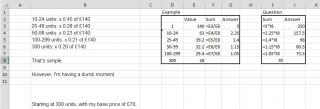-
Posts
11542 -
Joined
-
Last visited
-
Days Won
97
Content Type
Profiles
Forums
Gallery
Everything posted by monkeyseemonkeydo
-
D'oh. Astra had to be towed home from Evesham on Sunday and best guess from local garage is that it needs a new clutch, DMF and gearbox/diff. Think I'll be after a new car then...
-
Watched it last night from the comfort of my living room. Pretty much what I expected- entertaining but nothing amazing.
-
Fair enough . One thing that's caught me out before when things are tight is when the top cap has a machined rebate so that although the outer part is sitting on the stem the lower, smaller diameter part is hitting the steerer.
-
Sounds like your stem want sitting high enough so the top cap was tightening on to the steerer and not acting on the headset.
-
-
You're right- the $G$3's should be $G$2's so multiplying the discount value by the cost for one. That's the problem when you fake equations!
-
Take it that's what you meant there. I think you're pretty much doing what I'm doing but more proper . My answer is for kids who don't read good and want to do other stuff good too...
-
Sorry, only just found this. I feel I've let the speed of the prompt answers to strange maths questions side down . In the image I used the example with £140 to work out the relative ratios you wanted (i.e. the discount curve) based on the ratios given. The £140 is irrelevant so long as you're happy with the respective discounts (in fraction/percentage terms) for each jump in quantity. If the example had been based on an item selling for £345.32 for one item it would still work out the same assuming you were happy with the 0.45, 0.28, 0.23, ... As mentioned above, the other way of doing it is by starting with the 300 @ £x and multiplying x by 1/(whatever your max discount is). For the case of 0.2 as your max discount that would be 1/0.2 = 5. From that point you've got what you started with and you can then make whatever discount ratio/curve you want. I was lost by stirlingpowers reply too! Edit: For any discount amounts the above way is probably the way to go and use something like the following: So all you need is how much you want for 300+ (or whatever) items and a discount 'curve' for the various quantities (including the maximum allowable discount for the 300+) and you'll be able to work out the respective values from there.
-

Ol' girl restored - Ashton Tribute
monkeyseemonkeydo replied to Crashtest33's topic in Bike Pictures
I bet you $654.17 that I could get a set between the 23rd and 30th June... -

Ol' girl restored - Ashton Tribute
monkeyseemonkeydo replied to Crashtest33's topic in Bike Pictures
Interesting build. It's crying out for some CODA cranks! Or had he gone beyond those by the time he stopped using the red Beast of the East? -
Awesome video, let down only by the ponytail!
-
Does that help/make sense? (Click on it to make it big enough to actually see!) Basically from the example you give you can work out what multiplier can get from £28 for 300 to £29.40 for 100 (1.05 in that case) and so on and you can then just use those same multipliers starting at £70 for 300 (or whatever price you want).
-
I somehow missed the 50-99 line so everything got shuffled a line. Fixed now Is that (post 7) what you need Mike?
-
1 unit: £70 x 5 10-24 units: £70 x 2.25 25-49 units: £70 x 1.4 50-99 units: £70 x 1.15 100-299 units: £70 x 1.05 300 units: £70 Truth is I don't even know. I used your example in the first post to reverse engineer multipliers to go back up from the 300 @ £70 mark. I'm sure someone can describe it properly but I think it's to do with 1/your ratio shown above...
-
1 unit: £350 10-24 units: £157.50 25-49 units: £98 50-99 units: £80.50 100-299 units: £73.50 300 units: £70
-
He wasn't sure what the backmarker did but he was either spooked by Bruce or tried to follow him through before clipping the bank right in front of MD and Dunlop had nowhere to go. Haven't heard what happened to the backmarker but take it he's relatively ok.
-
I knew there was something silly with Montys... Crazy Spaniards. I would love one though! If only I had a spare £2400 kicking around...
-
Because Monty frames are 110mm spaced and Chris King hubs are 116mm.
-
That thing is sexual! Please get black cranks though!
-
Just brought () a couple of roof bike racks on eBay to match a pair I already have and not only did the guy knock a bit off and accept an offer but he then went out of his way to supply them with locks to match what my current ones have so they're all keyed alike! Legend!
-
Just watching the TT coverage on ITV4 and MD looks like he's about to headbutt anyone he's talking to... even when he's happy.
-
I've always thought he was a bit of a dick. Fast, sure, but a dick nonetheless. Edit: MD that is, not bing's dad...
-
Michael Dunlop has left the Milwaukee Yamaha team a couple of days into the TT fortnight because he doesn't feel the R1s are competitive enough to challenge for wins. Unprofessional much?
-
I have no idea how I managed to live so long without a homemade headset remover. It makes life so much easier! All for the sake of a length of aluminium tube and a hacksaw.






